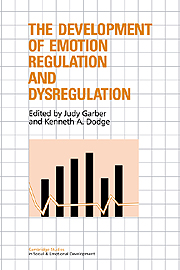Book contents
- Frontmatter
- Contents
- List of contributors
- Preface
- Part I Introduction
- Part II Early development
- Part III Physiological regulation
- Part IV Cognitive regulation
- 8 Emotion and social information processing
- 9 Strategies and mechanisms for the personal and social control of emotion
- 10 The regulation of sad affect: An information-processing perspective
- Part V Psychopathology
- Part VI Integration
- Author index
- Subject index
9 - Strategies and mechanisms for the personal and social control of emotion
Published online by Cambridge University Press: 26 March 2010
- Frontmatter
- Contents
- List of contributors
- Preface
- Part I Introduction
- Part II Early development
- Part III Physiological regulation
- Part IV Cognitive regulation
- 8 Emotion and social information processing
- 9 Strategies and mechanisms for the personal and social control of emotion
- 10 The regulation of sad affect: An information-processing perspective
- Part V Psychopathology
- Part VI Integration
- Author index
- Subject index
Summary
Achieving the effective regulation of emotion is one of the most important aspects of personality and social development. Philosophical perspectives on the character of humankind, such as those espoused by Hobbes (1651/1968) or Rousseau (1763/1974), as well as theories of personality and personality development, frequently begin with an assumption about an infant's affective character and abilities for self-regulation. From this foundation they then build a theory of character and its development, integrating issues of regulation and emotional expression. Rousseau was more optimistic in his view of infants as “pure” or basically moral and only subsequently corrupted by society, whereas most philosophers and theorists have held darker views of the clay from which personhood is molded. Thus, it has been more common to view infants as full of seething, vicious drives that are insensitive to others and potentially destructive (Freud, 1905/1953; 1935/1960; 1940/1964; Hobbes, 1651/1968), or at the very least untrammeled and in need of regulation, first from others but subsequently from the self.
The focus of this chapter, consistent with the focus of the entire book, is on the strategic control of emotion and the mechanisms by which such control may be established. Given the importance of understanding factors that influence the effective or ineffective regulation of emotion, one may ask whether there are any “paths” to regulation: constituent or contributory processes, abilities, motives, experiences, or characteristics that help determine the capability for affect regulation, the accomplishment of such regulation, or the failure to regulate accurately or effectively (dysregulation). Such paths might best be construed as conceptual groupings of factors that form a sequence of precursors for effective or ineffective regulation.
- Type
- Chapter
- Information
- The Development of Emotion Regulation and Dysregulation , pp. 182 - 207Publisher: Cambridge University PressPrint publication year: 1991
- 19
- Cited by



